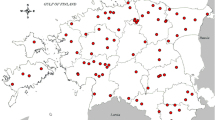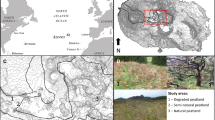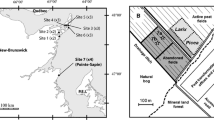Abstract
Increasing human activity continues to threaten peatlands, and as the area of natural mires declines, our obligation is to restore their ecosystem functions. Several restoration strategies have been developed for restoration of extracted peatlands, including “The moss layer transfer method”, which was initiated on the Tässi extracted peatland in central Estonia in May 2012. Three-year study shows that despite the fluctuating water table, rainfall events can compensate for the insufficient moisture for mosses. Total plant cover on the restoration area attained 70 %, of which ~60 % is comprised of target species—Sphagnum mosses. From restoration treatments, spreading of plant fragments had a significant positive effect on the cover of bryophyte and vascular plants. Higher water table combined with higher plant fragments spreading density and stripping of oxidised peat layer affected positively the cover of targeted Sphagnum species. The species composition in the restoration area became similar to that in the donor site in a natural bog. Based on results, it was concluded that the method approved for restoration in North America gives good results also in the restoration of extracted peatland towards re-establishment of bog vegetation under northern European conditions.







Similar content being viewed by others
References
Anderson P (2014) Bridging the gap between applied ecological science and practical implementation in peatland restoration. J Appl Ecol 51:1148–1152
Aronson MFJ, Galatowitsch S (2008) Long-term vegetation development of restored prairie pothole wetlands. Wetlands 28(4):883–895
Backėus I (1988) Weather variables as predictors of Sphagnum growth on a bog. Holarctic Ecol 11(2):146–150
Bret-Harte MS, Shaver GR, Chapin FS III (2002) Primary and secondary stem growth in arctic shrubs: implications for community response to environmental change. J Ecol 90:251–267
Campbell DR, Rochefort L, Lavoie C (2003) Determining the immigration potential of plants colonizing disturbed environments: the case of milled peatlands in Quebec. J Appl Ecol 40:78–91
Caners RT, Macdonald SE, Belland RJ (2009) Recolonization potential of bryophyte diaspore banks in harvested boreal mixed-wood forest. Plant Ecol 204:55–68
Chirino C, Campeau S, Rochefort L (2006) Sphagnum establishement on bare peat: the importance of climatic variability and Sphagnum species richness. Appl Veg Sci 9(2):285–294
Clymo RS, Hayward PM (1982) The ecology of Sphagnum. In: Smith AJE (ed) Bryophyte ecology. Chapman and Hall, London, pp 229–289
Constanza R, d’Arge R, de Groots R, Farber S, Grasso M, Hannon B, Limburg K, Naeem S, O’Neill RV, Paruelo J, Raskin RG, Sutton P, van den Belt M (1997) The value of the world’s ecosystem services and natural capital. Nature 387:253–260
Corson A, Campbell D (2013) Testing protocols to restore disturbed Sphagnum—dominated peatlands in the Hudson Bay Lowland. Wetlands 33:291–299
Crum H (1984) North American Flora. Series II, part 11, Sphagnopsida. Sphagnaceae. The New York Botanical Garden, New York
Eggelsmann R (1988) The rewetting of raised bogs. Geowissenschaften 11:317–322
Gerdol R (1996) The seasonal growth pattern of Sphagnum magellanicum Brid. In different microhabitats on a mire in the southerb Alps (Italy). Oecologia 5(1):13–20
Gonzáles E, Rochefort L, Boudreau S, Hugron S, Poulin M (2013) Can indicator species predict restoration outcomes early in the monitoring process? A case study with peatlands. Ecol Indic 32:232–238
Gonzáles E, Rochefort L, Boudreau S, Poulin M (2014) Combining indicator species and key environmental and management factors to predict restoration success of degraded ecosystems. Ecol Indic 46:156–166
González E, Rochefort L (2014) Drivers of success in 53 cutover bogs restored by a moss layer transfer technique. Ecol Eng 68:279–290
Groeneveld EVG, Rochefort L (2005) Polytrichum strictum as a solution to frost heaving in disturbed ecosystems: a case study with milled peatlands. Restor Ecol 13(1):74–82
Hájek T, Beckett RP (2008) Effect of water content components on desiccation and recovery in Sphagnum mosses. Ann Bot-London 101(1):165–173
Heikkilä H, Lindholm T, Jakkola S (2002) Soiden ennallistamisopas. A guide for the restoration of peatland habitats. Metsähallituksen luonnonsuojelulkaisuja 66:1–124
Hill MO, Bell N, Gruggeman-Nannenga MA, Brugues M, Cano MJ, Enroth J, Flatberg KI, Frahm J-P, Gallego MT, Garilleti R, Guerra J, Hedenäs L, Holyoak DT, Hyvönen J, Ignatov M, Lara F, Mazimpaka V, Muňoz J, Söderström L (2006) An annotated checklist of the mosses of Europe and Macaronesia. J Bryol 28:198–267
Hoyo Y, Tsuyuzaki S (2014) Habitat differentiation between Drosera anglica and D. rotundifolia in a post-mined peatland, Northern Japan. Wetlands 34:943–953
Ilomets M (1996) Temporal changes of Estonian peatlands and carbon balance. In: Punning J-M (ed) Estonia in the system of global climate change. Institute of Ecology. Publications 4:65–74
Ingerpuu N, Nurkse K, Vellak K (2014) Bryophytes in Estonian mires. Est J Ecol 63(1):3–14
Joosten JHJ (1992) Bog regeneration in The Netherlands: a review. In: Bragg OM, Hulme PD, Ingram HAP, Robertson RA (eds) Peatland Ecosystems and Man: An Impact Assessment. Department of Biological Sciences, University of Dundee, UK pp 367–373
Joosten H (2008) The IMCG Global Peatland Database. http://www.imcg.net/pages/publications/imcg-materials.php?lang=EN. Assessed 20 February 2015
Kalamees R, Püssa K, Zobel K, Zobel M (2012) Restoration potential of the persistent soil seed bank in successional calcareous (alvar) grasslands in Estonia. Appl Veg Sci 15(2):208–218
Kask M (1982) A list of vascular plants of Estonian peatlands. In: Frey T, Masing V, Roosaluste E (eds) Peatland ecosystems. Academy of Sciences of the Estonian SSR, Tallinn, pp 39–49
Konvalinková P, Prach K (2014) Environmental factors determining spontaneous recovery of industrially mined peat bogs: A multi-site analysis. Ecol Eng 69:38–45
Kukk T, Kull T (eds) (2005) Atlas of the Estonian Flora. Institute of Agricultural and Environmental Sciences of the Estonian University of Life Sciences, Tartu
Laberge V, Rochefort L, Poulin M (2013) Ericaceae stabilize peat and foster Sphagnum majus establishment at pool margins in restored peatlands. Aquat Bot 111:1–8
Lavoie C, Marcoux K, Saint-Louis A, Price JS (2005a) The dynamics of a cotton-grass (Eriophurum vaginatum L.) cover expansion in a vacuum-mined peatland, southern Québec, Canada. Wetlands 25(1):64–75
Lavoie C, Saint-Louis A, Lachance D (2005b) Vegetation dynamics on an abandoned vacuum-mined peatland: five years of monitoring. Wetl Ecol Manag 13(6):621–633
Maljanen M, Sigurdsson BD, Gudmundsson J, Óskarsson H, Huttunen JT, Martikainen PJ (2010) Greenhouse gas balances of managed peatlands in the Nordic countries—present knowledge and gaps. Biogeosciences 7:2711–2738
McCarter CPR, Price JS (2013) The hydrology of the Bois-des-Bel bog peatland restoration: 10-years post-restoration. Ecol Eng 55:73--81
McCarter CPR, Price JS (2014a) Ecohydrology of Sphagnum moss hummocks: mechanisms of capitula water supply and simulated effects of evapotranspiration. Ecohydrology 7(1):33–44
McCarter CPR, Price JS (2014b) The hydrology of the Bois-des-Bel peatland restoration: hydrophysical properties limiting connectivity between regenerated Sphagnum and remnant vacuum harvested peat deposit. Ecohydrology 8(2):173–187
McNeil P, Waddington M (2003) Moisture controls on Sphagnum growth and CO2 exchange on a cutover bog. J Appl Ecol 40:354–367
Millennium Ecosystem Assessment (2005) Ecosystems and human well-being: wetlands and water synthesis. World Resources Institute, Washington DC
Money RP, Wheeler BD (1999) Some critical questions concerning the restorability of damaged raised bogs. Appl Veg Sci 2(1):107–116
Orru M (1992) Eesti turbavarud (Estonian peat resources). Eesti Geoloogiakeskus, Tallinn
Paal J (ed) (2011) Jääksood, nende kasutamine ja korrastamine. Keskkonnainvesteeringute Keskus & Eesti Turbaliit, VALI trükikoda, Tartu
Paal J, Leibak E (2011) Estonian mires: inventory of habitats. Publication of the Project “Estonian Mires Inventory completion for maintaining biodiversity”. Regio, Tartu
Pakalne M, Strazdina L (eds) (2013) Raised bog management for the biological diversity conservation in Latvia. University of Latvia, Riga
Poulin M, Andersen R, Rochefort L (2013) A new approach for tracking vegetation change after restoration: a case study with peatlands. Restor Ecol 21(3):363–371
Pouliot R, Rochefort L, Karofeld E, Mercier C (2011) Initiation of Sphagnum hummocks in bogs and the presence of vascular plants: is there a link? Acta Oecol 37(4):346–354
Pouliot R, Rochefort L, Karofeld E (2012) Initiation of microtopography in re-vegetated cutover peatlands: evolution of plant species composition. Appl Veg Sci 15(3):369–382
Prach K, Lencová K, Ŕehounková K, Dvořáková H, Jirová A, Konvalinková P, Mudrák O, Novák J, Trnková R (2013) Spontaneous vegetation succession at different central European mining sites: a comparison across seres. Environ Sci Pollut R 20(11):7680–7685
Quinty F, Rochefort L (2003) Peatland restoration guide. Second edition. Canadian Sphagnum Peat Moss Accociation, New Brunswick Department of Natural Resources and Energy, Québec
Ramst R, Orru M (2009) Eesti mahajäetud turbatootmisalade taastaimestumine. Eesti Põlevloodusvarad ja – jäätmed 1:6–7
Robroek BJM, van Ruijven J, Schouten MGC, Breuwer A, Crushell PH, Berendse F, Limpens J (2009) Sphagnum re-introduction in degraded peatlands: the effects of aggregation, species identity and water table. Basic Appl Ecol 10(8):697–706
Rochefort L, Lode E (2006) Restoration of degraded boreal peatlands. In: Wieder RK, Vitt DH (eds) Boreal peatland ecosystems. Ecological studies 188. Springer, Berlin Heidelberg, pp 381–423
Rochefort L, Nondedeu FI, Boudreau S, Poulin M (2013) Comparing survey methods for monitoring vegetation change through time in a restored peatland. Wetl Ecol Manag 21(1):71–85
Rochefort L, Quinty F, Campeau S, Johnson K, Malterer T (2003) North American approach to the restoration of Sphagnum dominated peatlands. Wetl Ecol Manag 11:3--20
Salm J-O, Kimmel K, Uri V, Mander Ü (2009) Global warming potential of drained and undrained peatlands in Estonia: a synthesis. Wetlands 29(4):1081–1092
Salonen V (1994) Revegetation of harvested peat surfaces in relation to substrate quality. J Veg Sci 5:403–408
Schumann M, Joosten H (2008) Global peatland restoration manual. http://www.imcg.net/media/download_gallery/books/gprm_01.pdf. Assessed 20 February 2015
Söderström L, Urmi E, Váňa J (2007) The distribution of Hepaticae and Anthocerotae in Europe and Macaronesia—update 1–427. Cryptogam Bryol 28(4):299–350
Stoneman R, Brooks S (1997) Conserving bogs. The Management Handbook. The Stationery Office Ltd, Edinburgh
Sundberg S, Rydin H (2002) Habitat requirements for establishment of Sphagnum from spores. J Ecol 90:268–278
Triisberg T, Karofeld E, Paal J (2011) Re-vegetation of block-cut and milled peatlands: an Estonian example. Mires and Peat 8: Article 5, 1–14
Triisberg T, Karofeld E, Paal J (2013) Factors affecting the re-vegetation of abandoned extracted peatlands in Estonia: a synthesis from field and greenhouse studies. Est J Ecol 62(3):192–211
Triisberg T, Karofeld E, Liira J, Orru M, Ramst R, Paal J (2014) Microtopography and properties of residual peat are convenient indicators for restoration planning of abandoned extracted peatlands. Restor Ecol 22(1):31–39
Tuittila ES, Rita H, Vasander H, Laine J (2000) Vegetation patterns around Eriophorum vaginatum L. tussocks in a cut-away peatland in southern Finland. Can J Botany 78:47–58
Van Gaalen KE, Flanagan LB, Peddel DR (2007) Photosynthesis, chlorophyll fluorescence and spectral reflectance in Sphagnum moss at varying water contents. Oecologia 153:19–28
Vasander H, Tuittila E-S, Lode E, Lundin L, Ilomets M, Sallantaus T, Heikkilä R, Pitkänen M-L, Laine J (2003) Status and restoration of peatlands in northern Europe. Wetl Ecol Manag 11(1):51–63
Vellak K, Ingerpuu N, Karofeld E (2013) Eesti turbasamblad. The Sphagnum mosses of Estonia, Tartu Ülikooli Kirjastus
Verhoven JTA (2014) Wetlands in Europe: perspectives for restoration of a lost paradise. Ecol Eng 66:6–9
Wagner KJ, Gallagher SK, Hayes M, Lawrence BA, Zedler JB (2008) Wetland restoration in the new millennium: do research effort match opportunities? Restor Ecol 16(3):367–372
Wheeler BD, Shaw SC (1995) Restoration of damaged peatlands. Wiley, London
Acknowledgments
This study was co-financed by the following research projects: SF0180012s09, SF0180025s12, IUT34-7, IUT34-9 and by the EU Regional Development Fund (Centre of Excellence FIBIR) and Kalloveen BvBa. We thank for H. Oosterkamp, workers from AS Kraver and others for their help in the field and R. Burton for proof reading the manuscript.
Author information
Authors and Affiliations
Corresponding author
Additional information
Responsible editor: Hailong Wang
Rights and permissions
About this article
Cite this article
Karofeld, E., Müür, M. & Vellak, K. Factors affecting re-vegetation dynamics of experimentally restored extracted peatland in Estonia. Environ Sci Pollut Res 23, 13706–13717 (2016). https://doi.org/10.1007/s11356-015-5396-4
Received:
Accepted:
Published:
Issue Date:
DOI: https://doi.org/10.1007/s11356-015-5396-4




